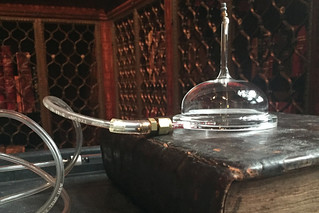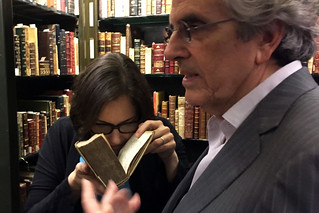
PREV ARTICLE
NEXT ARTICLE
FULL ISSUE
PREV FULL ISSUE
STOP AND SMELL THE BOOKSDavid Sundman writes: Fellow book lovers may find this article on capturing the aroma of old books using the 1906 Morgan Library as a case study, of some interest. As you know financier J. P. Morgan was quite a collector of coins.
“People in my field are interested in what makes buildings significant,” Jorge Otero-Pailos, professor and director of historic preservation at Columbia, said in an interview on Wednesday. “In fact, people’s memories are what make buildings culturally significant. And smell is the most direct way to those memories, but we pay so little attention to it.” Over the last year, he and seven graduate students have been conducting a project in collaboration with Morgan, with the help of Christine Nelson, curator of literary and historical manuscripts at the library. Their goal is perhaps someday to be able to convey a sense of the building’s history beyond just its look and feel. Their primary tool is a sampling device that looks like a contraption out of Jules Verne: a crystalline dome with plastic tubing snaking from its side. The sampler is placed gently on objects — rare books, furniture, carpets — to capture the escaping molecules that create a distinct smell.
“Under normal circumstances, we would have been kicked out of any museum if were behaving the way we behaved: We were on all fours, putting our heads under Morgan’s desk, smelling his cigar box, the aromas inside his personal book vault, which were still very strong,” said Mr. Otero-Pailos, who has been exploring the role of smell in preservation for almost a decade. Ms. Nelson, who has worked at the Morgan for 26 years, said: “One of the reasons I was very drawn to working with this project was that for years people have come to me and said: ‘Oh God, it must smell so great where you work! I remember that old book smell from my favorite library so well.’ Everybody has some sort of olfactory memory of a library that probably had an effect on their lives.” She added: “For me as a librarian, I’ve always thought about the question: Is there really a single old-book smell? I feel very strongly that there’s not, and now I’m going to get to see the proof.” That proof is being percolated over the next few months in a Manhattan lab at International Flavor and Fragrances, a company that produces smells and tastes for everything from colognes to detergents and candies. Besides books like a 16th-century calfskin-bound volume of Jacobus de Voragine’s “The Golden Legend,” what does a shelf of Circassian walnut that Morgan undoubtedly drew volumes from smell like? Or a box of his cigars, Havanas by Pedro Murias, circa 1910? Or a 1905 Otis elevator? For that matter, what might these things have smelled like during Morgan’s time or, for the rare volumes, centuries ago when they were new from the printer and binder? And could there be some Gilded-Age perspiration still lingering somewhere in the mix? During the 1907 financial panic, Morgan famously locked a group of bankers in the library overnight to force them to come to an agreement to save the economy.
To read the complete article, see:
Joe Esposito earlier forwarded the original article in the art blog Hyperallergic which drew attention to the project.
-Editor
“There is no single old book smell, and I associate that typical smell with a book that hasn’t been in a stable environment,” said Christine Nelson, curator of literary and historical manuscripts at the Morgan Library & Museum. And stability is a major concern for the Manhattan institution with its incredible collection of books dating back to the fifth century. Nelson and a group of students from the Columbia Graduate School of Architecture, Planning and Preservation (GSAPP), who gathered in the Morgan’s conservation lab, were deeply inhaling the scents of a selection of old books to consider what the place may have smelled like way back in 1906, the year that John Pierpont Morgan’s stately McKim, Mead and White-designed library was completed. And whether or not the windows were open in J. P. Morgan’s day was on the mind of Jorge Otero-Pailos, who is teaching this experimental historic preservation class. Street smells from Gilded Age New York could have wafted through the windows, mingling with the collection of rare tomes from across various eras, and the cigar puffing of Morgan himself. “I try to get students to rethink how we can preserve objects in a creative way that reengages people with those objects,” he said. “The smell of a room can bring you to that room faster than a picture,” Benaim remarked. To create what he called a “reconstruction of an epoch,” the students and researchers are delicately capturing the smells of different objects and historic areas of the 1906 Morgan. They’ve descended to the basement, with its antique Otis elevator works, examined the fireplace, and climbed up to a 16th-century tapestry, which is the only textile known to date to J. P. Morgan’s time. Their main tool, in addition to their curious noses, is a small glass dome that can gently rest on a centuries-old book without damaging it, collecting its character with molecules on a wax needle (a technique known as headspace technology). “The bell acts as a way of concentrating what is there,” Benaim explained. “It can pick up parts per billion of ingredients in the atmosphere.” Otero-Pailos said that it was so precise “none of us could wear cologne that day.” For now, the project is in its experimental phase. Ultimately, Otero-Pailos hopes to generate a methodology that could be replicated, as currently most olfactory practices relate to the perfume industry. As Nelson pointed out, the “end product is not the entire purpose.” Rather, it’s this idea of rethinking relationships to space through smell, and she affirmed as a longtime employee at the Morgan, it’s been a powerful reconnection to her early days at the museum. “Revisiting its old nooks and crannies, it has for me conjured a lot of memories,” she said. “It’s a living space, and it’s an evolving space.”
To read the complete article, see:
The Numismatic Bibliomania Society is a non-profit organization promoting numismatic literature. See our web site at coinbooks.org. To submit items for publication in The E-Sylum, write to the Editor at this address: whomren@gmail.com To subscribe go to: https://my.binhost.com/lists/listinfo/esylum All Rights Reserved. NBS Home Page Contact the NBS webmaster 
|

